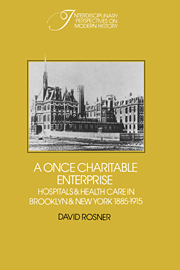Book contents
- Frontmatter
- Contents
- Preface
- Introduction
- 1 Health care and community change
- 2 Embattled benefactors: the crisis in hospital financing
- 3 Social class and hospital care
- 4 Conflict in the new hospital
- 5 Taking control: political reform and hospital governance
- 6 Consolidating control over the small dispensary: the doctors, the city, and the state
- 7 The battle for Morningside Heights: power and politics in the boardroom of New York Hospital
- 8 Looking backward
- Notes on sources
- Notes
- Select bibliography
- Index
4 - Conflict in the new hospital
Published online by Cambridge University Press: 07 October 2009
- Frontmatter
- Contents
- Preface
- Introduction
- 1 Health care and community change
- 2 Embattled benefactors: the crisis in hospital financing
- 3 Social class and hospital care
- 4 Conflict in the new hospital
- 5 Taking control: political reform and hospital governance
- 6 Consolidating control over the small dispensary: the doctors, the city, and the state
- 7 The battle for Morningside Heights: power and politics in the boardroom of New York Hospital
- 8 Looking backward
- Notes on sources
- Notes
- Select bibliography
- Index
Summary
Despite significant efforts to attract merchants and other white-collar workers by advertising comfortable accommodations and new services, hospital trustees were forced to admit that only a few more such patients actually came to the hospital. By and large the hospital was charging the very working-class patients who had previously used its services without charge, and these patients were bringing in only limited funds. Trustees came to realize that even if middle-class clients were influenced by pleasant accommodations and advertising, they were still the patients of private doctors and would enter the hospital only at those doctors' suggestion. Because family doctors would actually determine whether professionals, businessmen, and other people able to pay used the hospital, trustees came to see the necessity of forming an alliance with them.
For reasons related to their status in the hospital, even the most enthusiastic trustees could not help but have reservations about increasing the privileges of physicians. Throughout the nineteenth century, hospital trustees had direct control over the institutions they served, and their role was to function as the community's judge of who was worthy of admission to the facility. Once admitted, patients found that the trustees visited them regularly and took a personal, albeit paternalistic, interest in them. By the end of the century a number of things had caused control to begin slipping out of the trustees' hands. When hospital stays were shortened, trustees found it more difficult to oversee the physical and moral improvement of patients.
- Type
- Chapter
- Information
- A Once Charitable EnterpriseHospitals and Health Care in Brooklyn and New York 1885–1915, pp. 94 - 121Publisher: Cambridge University PressPrint publication year: 1982



